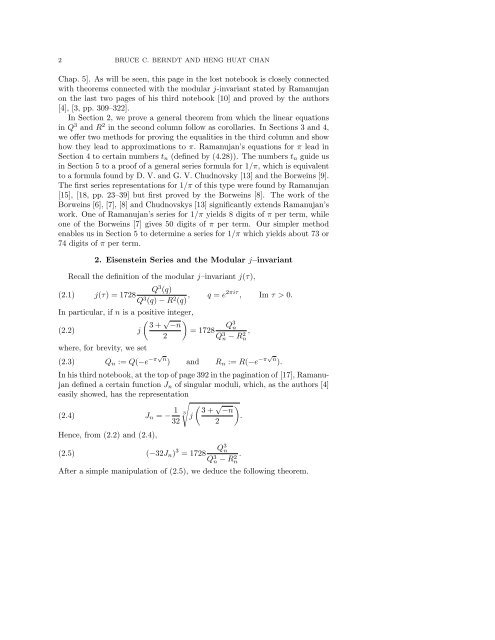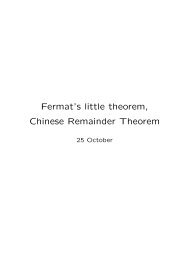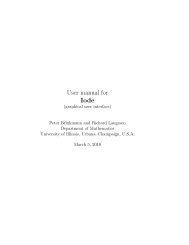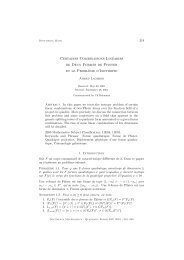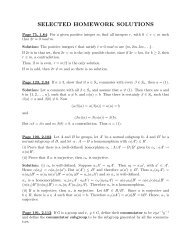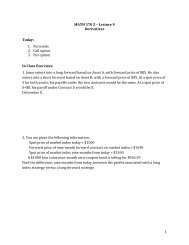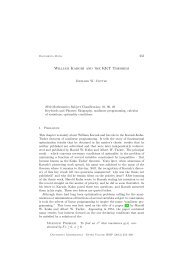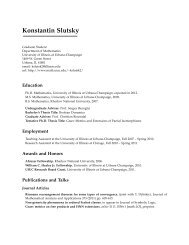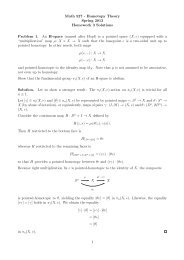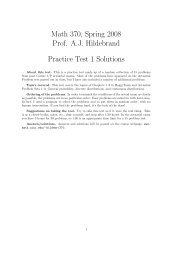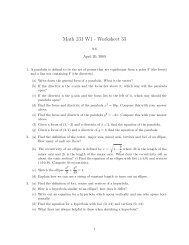Eisenstein series and approximations to pi - Mathematics
Eisenstein series and approximations to pi - Mathematics
Eisenstein series and approximations to pi - Mathematics
Create successful ePaper yourself
Turn your PDF publications into a flip-book with our unique Google optimized e-Paper software.
2 BRUCE C. BERNDT AND HENG HUAT CHAN<br />
Chap. 5]. As will be seen, this page in the lost notebook is closely connected<br />
with theorems connected with the modular j-invariant stated by Ramanujan<br />
on the last two pages of his third notebook [10] <strong>and</strong> proved by the authors<br />
[4], [3, pp. 309–322].<br />
In Section 2, we prove a general theorem from which the linear equations<br />
in Q 3 <strong>and</strong> R 2 in the second column follow as corollaries. In Sections 3 <strong>and</strong> 4,<br />
we offer two methods for proving the equalities in the third column <strong>and</strong> show<br />
how they lead <strong>to</strong> <strong>approximations</strong> <strong>to</strong> π. Ramanujan’s equations for π lead in<br />
Section 4 <strong>to</strong> certain numbers tn (defined by (4.28)). The numbers tn guide us<br />
in Section 5 <strong>to</strong> a proof of a general <strong>series</strong> formula for 1/π, which is equivalent<br />
<strong>to</strong> a formula found by D. V. <strong>and</strong> G. V. Chudnovsky [13] <strong>and</strong> the Borweins [9].<br />
The first <strong>series</strong> representations for 1/π of this type were found by Ramanujan<br />
[15], [18, pp. 23–39] but first proved by the Borweins [8]. The work of the<br />
Borweins [6], [7], [8] <strong>and</strong> Chudnovskys [13] significantly extends Ramanujan’s<br />
work. One of Ramanujan’s <strong>series</strong> for 1/π yields 8 digits of π per term, while<br />
one of the Borweins [7] gives 50 digits of π per term. Our simpler method<br />
enables us in Section 5 <strong>to</strong> determine a <strong>series</strong> for 1/π which yields about 73 or<br />
74 digits of π per term.<br />
2. <strong>Eisenstein</strong> Series <strong>and</strong> the Modular j–invariant<br />
Recall the definition of the modular j–invariant j(τ),<br />
(2.1) j(τ) = 1728<br />
Q 3 (q)<br />
In particular, if n is a positive integer,<br />
√ <br />
3 + −n<br />
(2.2) j<br />
2<br />
where, for brevity, we set<br />
Q 3 (q) − R 2 (q) , q = e2πiτ , Im τ > 0.<br />
= 1728 Q3n Q3 n − R2 ,<br />
n<br />
(2.3) Qn := Q(−e −π√ n ) <strong>and</strong> Rn := R(−e −π√ n ).<br />
In his third notebook, at the <strong>to</strong>p of page 392 in the pagination of [17], Ramanujan<br />
defined a certain function Jn of singular moduli, which, as the authors [4]<br />
easily showed, has the representation<br />
(2.4) Jn = − 1<br />
<br />
√ <br />
3 3 + −n<br />
j<br />
.<br />
32 2<br />
Hence, from (2.2) <strong>and</strong> (2.4),<br />
(2.5) (−32Jn) 3 = 1728 Q3 n<br />
Q 3 n − R 2 n<br />
.<br />
After a simple manipulation of (2.5), we deduce the following theorem.


